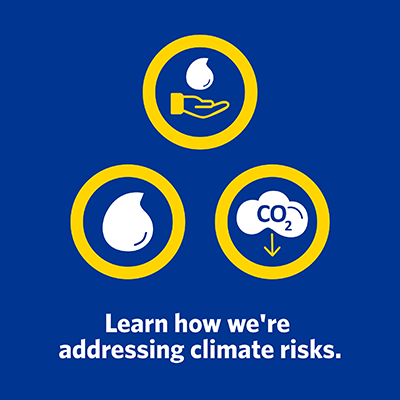Providing Safe, Clean Water Amid Climate Change
 September 21, 2023
September 21, 2023
by Chief Water Resource Sustainability Officer Ken Jenkins
2023 has proven to be another year of communities across the globe confronting the realities of climate change. Here at home, Californians have endured a wide range of extreme weather events, from heavy rainstorms and flooding in January and February that caused millions of dollars in damages to a tropical storm just last month—the first tropical storm to hit southern California in 84 years. The new “climate normal” includes not only severe storms, but also warm, dry weather that exacerbates deadly wildfires.
At Cal Water, we have long recognized climate change impacts, and have been planning for and taking actions to address these immediate and long-term effects. Beyond providing safe, clean water to more than two million Californians each day, we’ve made a conscious decision to reduce our own carbon footprint in our operations while continuing to drive efficiency across the board.
To support our customers and employees, and adapt to more extreme weather patterns, we have developed holistic methods to recognize and respond to a crisis. We have implemented a Wildfire Task Force to analyze and minimize the impact of wildfires across our operations, including mapping out high-risk service areas across the state, staging portable generators at key facilities, managing vegetation, and training our employees. We have created an Operations Rapid Response Team of nearly 30 Cal Water employees across the state to get boots on the ground faster in a variety of emergency situations. We’ve also installed permanent emergency generators to keep water flowing during power disruptions.
Looking to the future, we are proactively implementing new initiatives that drive sustainability and efficiency. We utilize a routing system for work orders that calculates truck routes that save not only fuel and reduce carbon emissions, but also time between appointments so we can respond to customers as quickly and efficiently as possible. We conduct water pump efficiency testing regularly and recalibrate or replace inefficient water pumps and motors. We also strive to operate our pumps during off-peak hours to put less strain on electric grids.
We are transitioning to renewable energy solutions and electrification, running some facilities on solar power, substituting electric-powered tools for conventional, gasoline-powered tools, and getting more electric or hybrid vehicles into our fleet. At one of our water facilities, we even have a hydropower recovery turbine, which returns power generated by the water leaving our tanks to the local grid.
While we’ve had a wet year, Cal Water is planning and preparing for more dry years ahead. To ensure water supply reliability for our communities amid climate change, we are focused on supply diversification and demand management. We’re working to diversify our supply sources through alternatives such as water reuse and brackish desalination. Additionally, water conservation continues to be a critical piece of our water reliability and climate change mitigation efforts, as it not only ensures that water is being used efficiently, it also reduces energy use and related greenhouse gas emissions.
Each of us has a role to play in confronting climate change, and we at Cal Water are implementing solutions to protect our planet and proactively ensure our customers can rely on us to deliver a safe and reliable water supply—no matter the weather or season.






